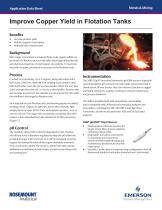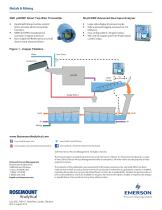 Website:
Emerson Automation Solutions - ROSEMOUNT
Website:
Emerson Automation Solutions - ROSEMOUNT
Group: Emerson Automation Solutions
Catalog excerpts

Metals & Mining Application Data Sheet Improve Copper Yield in Flotation Tanks Benefits Increase product yield Reduce reagent consumption Reduced labor requirements Background Rich copper concentrate is produced from crude copper sulfide ore by means of a flotation process that takes advantage of the physical and chemical properties of small copper ore particles. To maximize the yield of copper, pH control is necessary in the flotation tanks. Process Crushed ore (containing 1 to 2 % copper), along with water and a lime slurry, is fed into a ball mill. This rotating drum contains steel balls that further crush the ore to a fine powder. When the ore / lime slurry emerges from the mill, it is fed to a rake classifier. Particles that are too large to pass from the classifier are returned to the mill, while the overflow is discharged to flotation cells. Air is injected into the flotation cells, and foaming agents are added, creating a froth. Copper ore particles, due to their relatively light weight, become a part of this froth, while heavier particles, such as iron ore, do not. The copper-rich concentrate, containing 20 to 40 % copper, is then separated from the solution for further processing (Figure 1). pH Control The condition of the froth is directly dependent on pH. The flow rate of lime slurry is therefore regulated to keep the pH within the acceptable range. If pH is too low, iron will be entrapped as well as copper, decreasing the value of the copper ultimately recovered. If too much lime is added, the result is a dilute froth that requires additional concentration in later stages, increasing operating costs and wasting lime. Instrumentation The 396P TUpH™ Insertion/Submersion pH/ORP sensor is especially recommended for pH control in the high solids environment that is characteristic of lime slurries. Also, the reference junction is rugged and highly resistant to coating, resulting in reduced maintenance and process downtime. The 396P is available both with and without a preamplifier and is compatible with all Rosemount Analytical analyzers and transmitters, including the 5081 pH/ORP Smart Two-Wire Transmitter, and the multi-parameter 1056 and 56 dual input analyzers. 396P pH/ORP TUpH Sensor Polypropylene reference junction for longer sensor life in process solutions containing heavy solids. Disposable, one-piece construction is convenient and economical where minimal troubleshooting and maintenance downtime are of prime importance. Versatile. Can be used in numerous loop configurations with all Rosemount Analytical and other manufacturers’ instruments.
Open the catalog to page 1
Metals & Mining 5081 pH/ORP Smart Two-Wire Transmitter 56 pH/ORP Advanced Dual Input Analyzer Hand-held infrared remote control link to activate all the transmitter corrosion-resistant enclosure. Non-volatile EEPROM memory to hold data in event of power failure. Large color display of process trends. Data and event logging accessed via 2.0 Four configurable 4-20 alarm relays. PID control outputs and Time Proportional Control relays. Figure 1 - Copper Flotation Ball Mill Sludge Return jjfc www.youtube.com/user/RosemountAnalytica Emerson Process Management ©2013 Emerson Process Management....
Open the catalog to page 2All Emerson Automation Solutions - ROSEMOUNT catalogs and technical brochures
-
VPS 53 Vapor Pressure Sensor
2 Pages
-
EasyHeat™ XD Cable Kits
2 Pages
-
FRL Accessories
14 Pages
-
TankRadar Pro
32 Pages
-
Rosemount™ 2140 Level Detector
22 Pages
-
Roxar subsea PIG
2 Pages
-
Roxar subsea Sand monitor
2 Pages
-
Roxar subsea CM10K
2 Pages
-
Roxar PTPT15K
2 Pages
-
Rosemount TankRadar OFC
2 Pages
-
SW-300
4 Pages
-
DL8000
12 Pages
-
DeltaV Analyze
8 Pages
-
AMS Machine Works
4 Pages
-
DeltaV Executive Portal
7 Pages
-
1500XA Gas Chromatograph
8 Pages
-
Rosemount 975UR
4 Pages
-
Rosemount 975HR
4 Pages
-
Rosemount 975UF
4 Pages
-
Rosemount 975MR
4 Pages
-
CT5400 Process Gas Analyzer
4 Pages
-
CT2211 Leak Detection System
4 Pages
-
Desalination of Seawater
2 Pages
-
700XA Process Gas Chromatograph
12 Pages
-
SafeGuard Alarm Controller
2 Pages
-
Safety Monitoring
6 Pages
-
AMS Suite
16 Pages
-
Drinking Water Sht 2V2
2 Pages
-
Line Card
2 Pages
-
Drinking Water Industry
16 Pages
-
Explosion Proof Video Camera
2 Pages
-
Net Safety UV Flame Detector
4 Pages
Archived catalogs
-
UV/IRS Flame Detector
4 Pages
-
UVS Flame Detector
4 Pages























































































































































